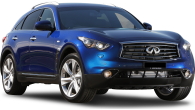BMW isn’t playing it safe when it comes to electrified vehicles. About a decade ago the company launched the concept car-like i8 hybrid sportscar and the ground-breaking i3 electric city hatch.
While it’s been mostly hybrids and plug-in hybrids since then, the German giant ramped things up in a big way this year. It has just launched three battery EVs in Australia – the i4 sedan, the X3-based iX3 medium SUV and the iX large SUV.
The latter is based on a dedicated all-electric architecture and represents the pinnacle of BMW’s electrification and technological ambitions – for now at least.
But it’s arriving years after some of its biggest rivals. Has BMW left its run too late? Or has it taken its time to craft a superior EV?
BMW IX 2022: Xdrive40
| Engine Type | 0.0L |
|---|---|
| Fuel Type | Electric |
| Fuel Efficiency | 0.0L/100km (combined) |
| Seating | 5 |
| Price From | $104,610 - $120,230 |
| Safety Rating |
|
Does it represent good value for the price? What features does it come with?
8 / 10
From launch BMW is offering two powertrains across three iX model grades in Australia.
The range starts with the xDrive40 from $135,900, before on-road costs, and moves up to the xDrive40 Sport at $141,900. The xDrive50 Sport – the only variant we drove – costs $169,900.
BMW will add the powerful M60 performance flagship to the iX range in the middle of 2022.
The iX undercuts the Tesla Model X (from $166,712), but it lines up closely with the Audi e-tron (from $137,100) and Jaguar I-Pace (from $137,832).

BMW has packed the iX with standard features, which is to be expected given its price point, and the lengthy list is more tech heavy than some of its rivals.
The xDrive40 comes with 21-inch aerodynamic alloy wheels, keyless entry and start, heated front seats, power adjustable front seats with a massage function, four-zone air conditioning, ambient lighting, a harman/kardon surround sound system, digital radio, wireless charging, and wireless Apple CarPlay and Android Auto.
Paying the extra $6000 for the xDrive40 Sport gets you a 'Sport Package', 22-inch alloy wheels and metallic paint.
The xDrive50 Sport adds features like a panoramic sunroof, adaptive air suspension, soft-close doors, 22-inch wheels and a four-wheel steering system.
Is there anything interesting about its design?
8 / 10
There has been a lot of healthy debate within the CarsGuide team regarding the iX’s bold exterior design. It is undoubtedly polarising, and it won’t be to everyone’s taste, but I am a big fan.
Probably the most contentious element is the front-end styling. The face includes a modern take on BMW’s signature quad headlights, but these units are the narrowest ever produced by BMW.
Those lights surround the enormous toothy grille. This is a feature BMW has rolled out on the X7 SUV and 4 Series range, causing a lot of debate.
Given the iX is an EV, the grille is closed off and hides the radars and other equipment for the driver assistance system. Vertical air curtains guide air flow to the massive 22-inch aerodynamic wheels, which are surrounded by sculpted wheel arches.

The door handles are flush with the door panels but they don’t pop out like they do on a Tesla or Jaguar – you just slip your hand in and under. Opening the doors reveals the frameless windows and it provides a peek under the skin.
Given how heavy EV batteries are, BMW has tried to trim as much fat as possible by producing the body with a mix of aluminium, high-strength steel, and carbon – the latter is visible in the door openings.
From the rear, the iX has a very broad shoulder line, giving it a wider stance on the road, and the C-pillar has a BMW ‘i’ brand signature flourish.
BMW has taken an edgy yet minimalist approach to the cabin. It is strikingly modern and has a premium ambience.

The minimalist design means the only buttons on the dash are the headlight controls and the front and rear windscreen demisters.
The lovely flat-bottom two-spoke steering wheel is reminiscent of the i3 but feels more premium, and even the audio controls are subtle.
BMW has added some bling with crystal-like elements for seat adjustment (now housed on the doors, like a Mercedes) gear shifter and more.
Overall, the iX cabin feels unique, luxurious and very special.

How practical is the space inside?
9 / 10
Up front, the beautifully designed perforated leather seats are incredibly plush but they’re also supportive – and don’t forget that massage function.
Storage wise, large bottles will fit in the front doors and there’s additional room for more items. The glove box is small and the central bin is average size, but has a handy tray for stowing phones and the like.
The centre console is split with controls for various functions at the top, as well as a slot for holding your phone upright, and a phone charging tray, two decent sized cupholders, two USB-C outlets and a 12-volt charger on the lower level. It’s well executed and doesn’t compromise function for style.
The panoramic glass sunroof features an electrochromic shade function, similar to those used on some airplanes. You simply hit a switch on the ceiling console and the glass changes to white, which BMW says keeps out UV rays and heat.

We drove the iX at the height of Melbourne summer and this function worked better than some material shade blinds in models from other brands. Very clever.
BMW’s latest 'iDrive 8' multimedia system is complex and it can take some time to find things. BMW’s aim is to integrate or hide some tech features when they’re not needed to avoid overwhelming the driver.
Yes, there’s a lot to it, but once you’ve familiarised yourself with the menu, it’s a clever system and surprisingly logical. The swipeable tiles on the home screen are customisable, as is the 12.3-inch curved digital instrument display.
The iX features gesture control, as well as voice recognition for certain commands, and 'BMW ID' that lets you check the status of the car, and even take a peek at the cameras, remotely via an app. We also used Apple CarPlay which connected without fault every time.

The five-seat iX features sumptuous leather seats in the second row offering decent support.
Being a dedicated EV, there’s no transmission tunnel and the base of the front console is set forward so there’s heaps of legroom for the rear centre seat. As a result, the iX is a genuine five seater.
In terms of overall size, the iX is larger than the iX3 and is closer in size to the X5. In fact, there’s more interior room than an X5, making for ample leg room behind my 183cm driving position, good toe room and heaps of headroom, even with the sunroof.
There are two sets of ISOFIX points on the outboard seats and three top tether points.
Rear-seat occupants have access to a fold-down armrest with pop-out cupholders, map pockets, digital climate controls, knee-level, chest-level and floor-mounted air vents, two USB-C ports on each seatback, an insert to clip in rear entertainment screens, a bunch of coat hooks, and decent bottle storage in the doors.
The iX has 500 litres of cargo space with the seats in place, expanding to 1750L with the rear seats folded. It’s a decent amount of volume and it easily fit our luggage in with room to spare, but the Audi e-tron can swallow 660L with all seats up.
Those rear seats can be folded via small levers in the boot area or next to the seats, and they fold 60/40 or 40/20/40.
Opening the power tailgate, which can be done via the motion sensor, reveals a nicely carpeted boot, cargo net hooks and bag hooks and a 12-volt charger.
There is no spare wheel, just a tyre repair kit, and the under-floor storage is taken up by the two charging cables.
What are the key stats for the motor and transmission?
9 / 10
There is no peeking under the bonnet of the iX because it doesn’t open. The only way it can be opened is by a BMW technician at a dealership. That also means it doesn’t have a front cargo area like you’d find in many other EVs.
All iX variants have two motors, one on each axle, for on-demand all-wheel drive traction, via a single-speed transmission that’s typical of an EV. The system is paired with a high-voltage lithium-ion battery housed under the floor.
The xDrive40 and xDrive40 Sport deliver combined power and torque outputs of 240kW/630Nm, allowing for a 0-100km/h sprint in 6.1 seconds.
The xDrive50 Sport pumps out 385kW/765Nm and completes the 0-100km/h dash in a very quick 4.6 seconds.
How much energy does it consume?
9 / 10
The xDrive40 is fitted with a 77kWh battery, allowing for a WLTP electric driving range of 425km. Moving into the xDrive50, the battery capacity increases to 112kWh and the driving range extends to 630km.
The combined energy consumption for the xDrive40 is 22.5kWh/100km and it is 23kWh for the xDrive50. For comparison, the official figure for the e-tron 55 quattro is 22.7kWh.
After a week of mixed urban, freeway and light regional driving in the xDrive50, and using air conditioning constantly in the summer heat, we recorded a consumption figure of 24kWh/100km.
Even though the stated range of the xDrive50 is 630km, we started our week in the car with 100 per cent charge, but the instrument cluster said it had 580km range.

BMW includes two free charging cables with the iX. One is for domestic use and the other for public charging. There is one charging port on the driver’s side of the vehicle and the iX has a Type 2 and Type 2 CCS plug.
Charging the xDrive40 from empty to 100 per cent via a regular household power point will take 44 hours, and around 66 hours for the xDrive50.
When connected to an 11kW, three-phase AC wallbox, the xDrive40 will charge from nothing to full capacity in eight hours and the xDrive50 takes 11 hours.
The iX comes with a five-year subscription for the Chargefox public EV charging network, allowing for unlimited free use of the 50kW fast chargers or the 350kW ultra-rapid chargers.
Using a DC fast charger, the xDrive40, which can take 150kW of charge, will get from 10 to 80 per cent capacity in about 31 minutes and the 200kW xDrive50 takes 35 minutes.

Warranty & Safety Rating
What safety equipment is fitted? What safety rating?
9 / 10
The iX was awarded a five-star ANCAP crash safety rating under the stringent 2020-2022 protocols.
BMW says the iX has the most extensive suite of driver assist systems of any BMW model ever. The vehicle’s computing platform includes five cameras, five radar sensors and 12 ultrasonic sensors to monitor its surroundings.
It also comes with autonomous emergency braking with intersection assist and pedestrian and cyclist detection, adaptive cruise control with stop and go, lane keep and steering assist, an exit warning, park assist, and a reversing camera.

The latter is displayed as a split-screen with a surround view and direct rear camera for extra rear visibility.
The 'Driving Assistant Professional' activates when the driver selects a desired speed via the adaptive cruise. It includes a lane centring function and the whole system is one of the most flawless lane keeping aids we’ve experienced.
The iX remained perfectly centred in its lane on freeways and the cruise responded instantly to changing traffic ahead. This is impressive stuff.
What does it cost to own? What warranty is offered?
7 / 10
The iX is covered by BMW’s three-year/unlimited kilometre warranty. This now falls short of the five-year/unlimited kilometre warranty offered by many of its rivals like Audi, Mercedes-Benz, Lexus, Genesis, and more.
The battery is covered by an eight-year/160,000km warranty and the iX also comes with eight years of complimentary roadside assistance.

Rather than having scheduled servicing for its vehicles, BMW uses a condition-based model, and that’s when the vehicle’s computer will tell you when it’s time to book it in for a service.
BMW offers iX buyers servicing packages, starting at $1520 for four years and $2195 for six years.
What's it like to drive?
9 / 10
BMW puts a lot of pressure on itself with its ‘Ultimate Driving Machine’ tagline. Thankfully the company has engineered the iX with driver engagement in mind.
Most EVs have brisk acceleration and the iX is no different. That sports car-beating 4.6-second 0-100km/h time feels spot on when accelerating, so much so it forces you back in your seat. Anyone trying to drag you at the traffic lights will be left in the dust.
The iX delivers its phenomenal power and torque flawlessly and keeps going even up seriously steep hills.
The battery’s placement under the floor makes for a low centre of gravity and balanced weight distribution for the most part.

However, at two-and-a-half tonnes, it’s a heavy vehicle and sometimes you feel its heft on the road. Given its height, it can be a little top heavy when cornering, but despite that, it’s surprisingly nimble on winding sections of road. There’s loads of grip too, aided by the all-wheel drive set-up and high-end tyres.
The iX has quick steering, which is weighted on the heavy side. Switching to Sport mode adds even more weight to the steering, and it also sharpens the throttle, firms up the ride and increases the growl of the cool synthetic EV sound.
The brakes feel slow to respond but I put that down to the regenerative braking, which helps recoup energy. The iX features adaptive regenerative braking as the default setting in drive.
The system uses the navigation and sensors to detect vehicles and intersections and automatically slow down. A dedicated regen braking mode is activated when moving the gear shifter to ‘B.'

BMW has managed to hit that difficult-to-achieve balance of dynamic capability and ride comfort.
Ride quality in the iX is impressive. It feels settled, regardless of the quality of the road. An unsealed section with loose gravel could not unsettle the car, and potholes and speed bumps barely register. There’s no vibration through the wheel either.
The cabin is incredibly hushed. In some EVs, road noise is more obvious because there is no internal combustion engine to drown it out. But BMW has done an exceptional job of noise suppression, adding to the iX’s plush, luxurious ride.
One of the iX’s few downsides is the massive turning circle. It is not the easiest vehicle to manoeuvre in tight urban streets.
Verdict
If BMW wanted to come out all guns blazing against its rivals from Tesla, Audi, Jaguar and others, then mission accomplished.
The iX is an incredibly impressive car that has put all of those manufacturers – and more – on notice.
It combines a luxurious interior and plush ride with a genuinely engaging drive experience as well as next-generation safety and on-board tech.
The fact that it has a useful driving range is the cherry on top.
The iX is the new benchmark for premium electric SUVs.
Pricing Guides










.jpg)


































.jpg)

.jpg)
.jpg)

.jpg)



.jpg)


Comments